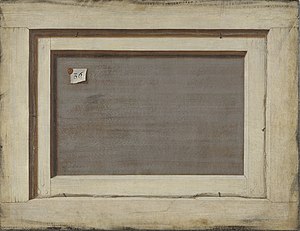Back of a painting

|
| Back of a painting |
|---|
| Cornelis Gijsbrechts , 1670 |
| Oil on canvas |
| 66.6 x 86.5 cm |
| State Art Museum Copenhagen |
The reverse of a painting (Rugzijde van een schilderij) is the title of an oil painting by the Dutch painter Cornelis Gijsbrechts . The unframed painting is a trompe-l'oeil and represents the back of a painting including a wooden picture frame. It was created in 1670 and is kept in the Kunstmuseum Copenhagen .
description
The painting shows the rear view of a medium-sized, horizontal rectangular painting . A mottled brown-gray canvas is stretched on a wooden stretcher frame and is framed by a picture frame that is about twice as wide, which clearly shows blackish signs of use. The four strips of the stretcher do not connect nails, but three wooden bolts each. With six more or less crooked nails, two each on the long sides, one each on the short side, the picture frame and stretcher are wedged together.
In the upper left corner of the canvas a piece of paper with the number 36 is attached by a patch of sealing wax .
The light falls from the top left onto the picture, so that the frame and stretcher cast strong L-shaped cast shadows and the “dog-ear” of the note also draws an irregular shadow spot on the canvas.
Trompe l'œil with picture frame

Cornelis Gijsbrechts, of whom only a few biographical data have survived, had specialized in painting trompe-l'œils. The present painting belongs to a series of paintings in which the painter uses picture frames to deceive the viewer's expectations. He varied the motif of a canvas that is detaching from the stretcher in many ways. In one of his vanitas still lifes , in which he arranges skulls, hourglasses, candlesticks and other vanitas props in a noble marble niche, the canvas in the upper corner is detached from the stretcher, thus denouncing the sublime staging as a deception.
In the picture on the back of a painting , disillusionment is carried to extremes. Leaning against the wall of a sales room, as Tom Lubbock suspects in his essay, the potential buyer, when he turns the picture over, encounters the real back of wood and canvas, “a true triumph of the art of eye deception”.
literature
- Georg Simmel : The picture frame. An aesthetic attempt. Articles and treatises 1901–1908, Vol. 1, ed. by Rüdiger Kramme, Angela Rammstedt and Otthein Rammstedt. In: Georg Simmel. Complete edition. Edited by Otthein Rammstedt, Volume 7, pp. 101-108. [1]
- Olaf Koester (Ed.): Bedrogen ogen. Geschilderde illusies van Cornelis Gijsbrechts. Exhibition catalog The Hague. Zwolle 2005.
Web links
- Tom Lubbock: Gijsbrechts, Cornelius: "The Reverse Side of a Painting" (1670). ( Memento of December 19, 2011 in the Internet Archive ) in: The Independent , February 2, 2007.
- Gijsbrechts, The Reverse of a Framed Painting, smk.dk
Individual evidence
- ^ Lubbock: Gijsbrechts, Cornelius: "The Reverse Side of a Painting" (1670) ( Memento from December 19, 2011 in the Internet Archive )